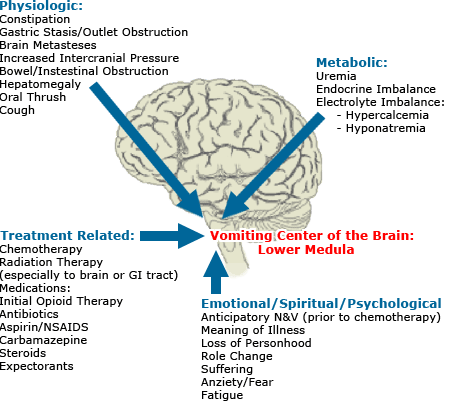Welcome Overview Pain Management Symptom Management |
 |
||||||||||
| Common Symptoms and Management in Advanced Disease Nausea and Vomiting Nausea and vomiting are symptoms experienced by approximately 40% to 60% of cancer patients, especially those with breast or stomach cancer. Nausea and vomiting are also often a consequence of chemotherapy treatments, and can be a temporary side effect when initiating opioid therapy. Quality of life and the ability to perform activities of daily living are significantly impacted by nausea and vomiting, and treatment should be directed at the cause as well as the symptoms themselves. Nausea is a subjective experience, influenced by past experiences, emotions, expectations and other contributing factors. The sensation of nausea can range from stomach discomfort that comes and goes in waves, to painful cramping, to an urgent need to vomit, depending on the patient. Nausea can occur without vomiting and is more common than vomiting. Vomiting is the “forceful ejection of the stomach or intestinal contents” and is controlled by the vomiting or emetic center in the brain stem. Several central and peripheral nerve pathways stimulate the vomiting center: through the cortex and the limbic system which is activated by certain smells, or remembered sensory experiences; the chemoreceptor trigger zone in the medulla oblongata which responds to chemical changes in the cerebrospinal fluid; the peripheral nerve pathways, which are stimulated by chemical changes in the blood and viscera; and the vestibular apparatus in the middle ear that responds to changes in position of the patient (Haughney, 2004). Vomiting can be a sudden occurrence and may or may not occur with nausea. Causes of nausea and vomiting  Treatment of nausea and vomiting Treatment of nausea and vomiting can be challenging. Modifying the diet Modifying the diet can help to decrease nausea and vomiting. Begin by eliminating spicy, fatty, or overly sweet foods. Bland foods such as rice, potatoes, crackers, dry toast etc. should be encouraged. Small frequent meals that are room temperature (warm foods may have a stronger odor) are recommended.
Drug Therapy Drug therapy is most likely to work if started prophylactically; the oral route is preferred if there has been no vomiting.
If Due To Anxiety Nausea and vomiting due to anxiety can also be treated with antihistamines or anticholinergics such as scopalomine. Relaxation and breathing techniques, techniques such as Therapeutic Touch, spiritual counseling, and life review are also very useful to relieve nausea caused in part by anxiety. These techniques should be initiated along with conventional pharmacological treatments for a more comprehensive plan of care. |
|||||||||||